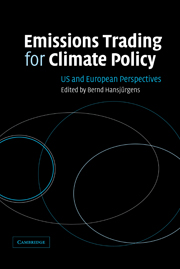Book contents
- Frontmatter
- Contents
- List of figures
- List of tables
- List of contributors
- Preface
- List of abbreviations
- 1 Introduction
- Part 1 Regulatory instruments for climate policy: theoretical aspects
- Part 2 The US approach to pollution control: lessons for climate policy
- Part 3 European policies to control greenhouse gases: the EU directive on emissions trading
- 9 Regulation or coordination: European climate policy between Scylla and Charybdis
- 10 Lobbying and CO2 trade in the EU
- 11 Greenhouse gas emissions trading in the EU: building the world's largest cap-and-trade scheme
- 12 Legal aspects of the European Emissions Trading Scheme
- 13 Emissions trading schemes in Europe: linking the EU Emissions Trading Scheme with national programs
- 14 Concluding observations
- Index
- References
10 - Lobbying and CO2 trade in the EU
Published online by Cambridge University Press: 22 September 2009
- Frontmatter
- Contents
- List of figures
- List of tables
- List of contributors
- Preface
- List of abbreviations
- 1 Introduction
- Part 1 Regulatory instruments for climate policy: theoretical aspects
- Part 2 The US approach to pollution control: lessons for climate policy
- Part 3 European policies to control greenhouse gases: the EU directive on emissions trading
- 9 Regulation or coordination: European climate policy between Scylla and Charybdis
- 10 Lobbying and CO2 trade in the EU
- 11 Greenhouse gas emissions trading in the EU: building the world's largest cap-and-trade scheme
- 12 Legal aspects of the European Emissions Trading Scheme
- 13 Emissions trading schemes in Europe: linking the EU Emissions Trading Scheme with national programs
- 14 Concluding observations
- Index
- References
Summary
Introduction
The world's first framework for international greenhouse gas emissions trading was proposed by the European Commission in its new and remarkable Directive Proposal of October 2001. This Directive Proposal was the outcome of a policy process started by the Commission in March 2000 when launching the Green Paper. It started, in the words of the Commission, “a debate across Europe on the suitability and possible functioning of emissions trading.” This is so because “Emissions trading is, firstly, an instrument for environmental protection, and, secondly, one of the policy instruments that will least impair competitiveness.” (CEU, 2001a) Thus, the idea is that emissions trading could ensure that the stated target levels are achieved without invalidating the stated EU strategic goal of becoming the world's leading economy within a decade (from the Lisbon Summit of 2000; see Svendsen, 2003).
We focus on two main differences between the Green Paper and the Directive Proposal, namely the choice of allocation rule and enforcement. By doing this it is possible to measure the effect of lobbying as the difference in proposed design between the Green Paper (before lobbying) and the final Directive Proposal (after lobbying). Lobbying may lead to an irrational policy outcome for all market participants because the proposed market system is most likely to break down as a result of market distortions.
- Type
- Chapter
- Information
- Emissions Trading for Climate PolicyUS and European Perspectives, pp. 150 - 161Publisher: Cambridge University PressPrint publication year: 2005
References
- 9
- Cited by

